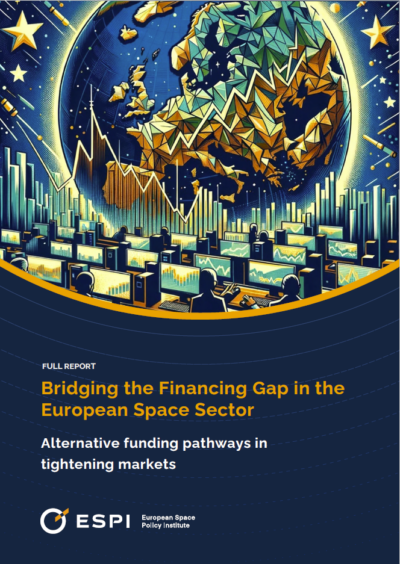Executive Brief No.13
1. Introduction
Recently, Richard Branson announced that Virgin Galactic will operate its first suborbital flight, which he will board, starting next year1. This latest development comes after a series of promising steps and announcements. However, in the last decade(s), technical drawbacks have been keeping this dream from becoming a reality for the about six hundred and fifty people who have already paid up to two hundred and fifty thousand dollars.
This year in May, the European Space Agency announced the kick-off of the construction in the UK of a rocket engine test facility, in partnership with institutional and industrial actors. Within three years it will be possible to fire airbreathing engines with the potential to revolutionise space launches, powering vehicles that can take off and land like aircraft, and allowing for flights up to five times the speed of sound, opening up the frontier of hypersonic air travel2.
2. What are the challenges and opportunities for suborbital flights?
The risks associated with suborbital flights are certainly high, since they operate in the domain of experimental flight vehicles, employing new technologies and with a very limited number of flight hours. In addition, some critical failures occurred in the past years, causing the loss of the pilot’s life as well as a substantial slowing of the development process. These elements clearly question the robustness of the initially foreseen business case, and require a thorough and critical analysis of future strategies.
A game changer, which emerged in recent years, is given by industrial alliances and strategic partnerships with institutional actors. In this latter case, providing services in the microgravity sciences domain represents a new opportunity for both the suborbital flights industry and the scientific communities. These flight opportunities could become an integral part of space agencies’ programmes and microgravity platforms portfolios, which nowadays encompass automatic capsules, sounding rockets, parabolic flights and drop towers, all currently used worldwide3. Many new actors entering the suborbital flights business are indeed considering strategic partnerships with space agencies, seeking technical support in the earlier development stages, and pooling expertise in specific domains such as aerospace medicine and passengers’well-being.
However, the element which can finally make suborbital flights happen, boosting the development and deployment of large fleets, is the potential strategic alliance between the aeronautical and space sectors. This type of alliance can be more easily supported in the United States and Japan, where the space agencies clearly encompass both space and aeronautics in their mandates. A good example is also offered by European industrial actors that are already engaging in R&D activities with JAXA on hypersonic flight technology development.
On the European institutional side, despite the promising ESA initiative in the UK, actors are somehow limited by the mandate of the respective agencies and institutions, and are not yet in a position to support a fully-fledged programme that covers joint space and aeronautics developments, enabling the realization of suborbital flights and hypersonic travel.
3. Way forward
The key question is whether one can foresee a more substantial role for the European public sector, including the extension of the agencies’ mandate and the appropriation of the necessary funding, or whether the development of the suborbital flights and hypersonic travel sectorsshould be left to private industry, significantly supported by the prompt definition and implementation of policy mechanisms and regulatory frameworks.At this point in time, in the absence of even a clear definition of the air-space interface, the regulatory and legal aspects of suborbital flights and hypersonic travel are still far from being addressed in a comprehensive and exhaustive manner4. This aspect, though, is highly relevant to successfully support private ventures and national efforts, which are being spent towards the development of a promising sector, including both the flight and ground segments, as well as of other related sectors which can greatly benefit, such as tourism and transportation industries worldwide. While the United States is already tackling the issue since some time, in Europe it would be advisable to develop a framework that enables the full exploitation of this business opportunity. An initial step in this direction was taken by the Italian Space Agency and the Italian National Civil Aviation Agency (Ente Nazionale per l’Aviazione Civile – ENAC), who signed a Memorandum of Cooperation on ‘Commercial Space Transportation’5 with the US Federal Aviation Administration, to support the nascent Space tourism sector by developing and regulating Space Ports6.
4. What could be the societal impacts of suborbital flights?
The overview effect, i.e. the change in awareness that has been experienced by the few individuals observing the Earth from Space has been a key outreach element for space agencies around the world. The implications of this could clearly be largely extended if an increasing number of people were to see the Earth from Space, eventually further developing in our societies feelings and behaviours associated with environmental awareness, democratization of space, sense of oneness and belonging to our “common home”. Considering the current status and the potential benefits, it is probably the right time to promote wider initiatives that encompass suborbital flights and hypersonic travel, and that may create synergies among different sectors and actors on a global scale, ultimately making this dream a reality.
References
1 Foust, Jeff. “All booked: Virgin Galactic says suborbital spaceflights are full until 2021.” 19 May 2017. SpaceNews. Accessed6 Jun 2017. Web: http://spacenews.com/all-booked-virgin-galactic-says-suborbital-spaceflights-are-full-until-2021/
2 ESA. “Test site for ESA-backed airbreathing engine.” 4 May 2017. Accessed 6 June 2017. Web: http://www.esa.int/Our_Activities/Space_Engineering_Technology/Test_site_for_ESA-backed_airbreathing_engine
3 Foust, Jeff. “Blue Origin joins NASA’s suborbital research flight program.” 3 Jun 2016. SpaceNews. Accessed 6 June 2017.Web: http://spacenews.com/blue-origin-joins-nasas-suborbital-research-flight-program/
4 United Nations Committee on Peaceful Uses of Outer Space (UNCOPUOS), Questions on suborbital flights for scientific missions and/or for human transportation. UN Doc A/AC.105/1039/Add.7 of 19 Dec 2016, Vienna, United Nations.
5 FAA.“Memorandum of Cooperation in the development of Commercial Space Transportation’”. 30 June 2016. Web: https://www.faa.gov/about/office_org/headquarters_offices/ast/programs/international_affairs/media/Memorandum_of_Cooperation_FAA_Italy_ENAC.pdf
6 ASI.“A spaceport in Italy?” 30 Jun 2016. Accessed 6 June 2017. Web: http://www.asi.it/en/news/a-spaceport-in-italy




